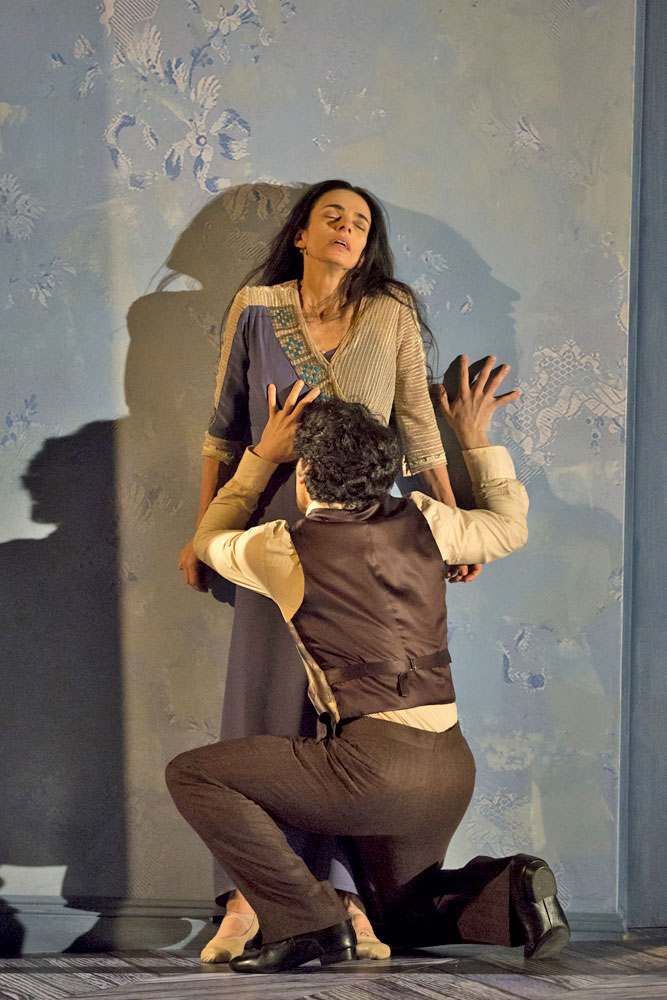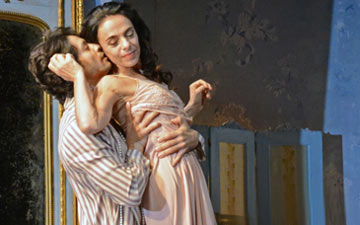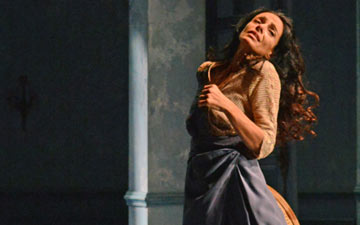
© Joan Marcus. (Click image for larger version)
Martha Clarke’s Chéri
Washington, Terrace Theater, Kennedy Center
1 October 2014
marthaclarke.com
www.kennedy-center.org
2013 Feature & interview on Clarke’s Cheri by Marina Harss
When the 49-year-old Léa, the main heroine of Martha Clarke’s Chéri, takes a long look at her reflection in the mirror, thoroughly examining every feature of her face, slowly running her fingers down her long neck, she does so with the grim realisation that her beauty – which was her pride and most valuable asset and the source of her fabulous wealth and sexual power over men – is no longer there. Léa faces the harsh realities of middle-age: she’s past her prime and her looks are fading with each passing year. As the saying goes, “Aging is not for the faint of heart.”
Choreographer Martha Clarke always had a special affection for the work of Colette (1873-1954), the celebrated French writer and actress, who in her time was considered a supreme master of boudoir romance. With her delicate, impressionistic style, which “bore the hallmarks of a pure French classicism,” Colette wrote about love as a battle, focusing on the destructive forces of love and the erosion of human spirit through love’s heartbreaks and misfortunes.
A few years ago, Clarke, now 70, re-discovered Colette’s writing anew. She was particularly drawn to her most famous Belle Époque novella “Chéri,” which was published in 1920. “It’s a story about aging,” Clark says. “And I was attracted to it as a woman who is moving on.”
The focal point of Chéri is a tumultuous love affair between the retired middle-aged courtesan Léonie Vallon, called Léa de Lonval, and a pampered and shallow young man, Frédérick Peloux, pet-named Chéri, more than 20 years her junior. It’s also about bittersweet consequences of such an unconventional liaison.
Léa had known Chéri since he was a child – he was the son of her best friend Charlotte Peloux, a former dancer and a fellow courtesan. Madame Peloux had no interest in mothering her son and Léa took the young boy under her wing. When Chéri turned 19 years old, their relationship evolved into a full-blown love affair. With the silent agreement of his mother, the romantic alliance lasted for nearly six years. That is, until Maman decided it was time for Chéri to get married to a bride of her choosing – a virginal and wealthy debutante, Edmée.

© Joan Marcus. (Click image for larger version)
Chéri dutifully follows his mother wishes, bidding farewell to Léa; but, unable to find happiness in his marriage, he returns to her six months later only to abandon her once again, this time by his own will. For the first time in his life, he sees his mistress with new eyes, suddenly realizing that she is no longer “an idolized young blonde” he used to know and love, but an aged woman, with “double chin and raddled neck.” Narcissistic and spoiled, Chéri cannot imagine himself to be a part of her fading world. He runs away from her as if escaping from prison.
Léa suffers but ultimately survives their separation. Chéri’s fate, however, is a bitter surprise, bringing his story – and his life – to an unexpected, tragic end.
Compressing the running time to a mere hour, Clarke re-imagines the novella and its sequel, “The Last of Chéri,” centering on the aspects which mattered to her most: the ups and downs of the turbulent romance of the two protagonists. As a result, Clarke’s Chéri, which had its premier last December at New York’s Signature Theatre and played to capacity audiences in the first week of October at the Kennedy Center’s Terrace Theater, is a gripping, sexually-charged dance-drama where passionate dancing unmasks the veiled emotions and deepest secrets of the two lovers in all their unadorned truthfulness.
Clarke’s staging hardly gives us the full measure of Colette. The production neither establishes the period atmosphere nor allows the audience to experience the pleasure of Colette’s fragrant, poetic style. Yet this Chéri is never short on real emotion. The choreography, although sometimes repetitive and trite, unearths the complexities of this mismatched and tragic love affair with dramatic insight and genuine honesty, getting straight to the novel’s theatrical heart.
Distilling the story to its bare bones, Clarke forgoes the secondary personages of the novels, with an exception of Madame Peloux, who in this production has only a speaking part (text written by playwright Tina Howe) and serves as an intermittent narrator. She slips in and out of the scenes reciting short, prickly monologues, in which she offers the audience her rather twisted side of the story.
The lovers’ emotional journey is expressed entirely in dance, in a series of duets and solos that capture the blissful moments of their erotic rapture as well as the devastating pain of their loneliness.
The opening pas de deux is an idyllic whirl of exhilaration and tenderness. The lovers playfully taunt each other, fighting over a strand of pearls; then joyfully reconcile, floating across the stage in a series of heart-hugging embraces; but when Madame Peloux announces the news of Chéri’s impending marriage, a somber tone, like a fog, clouds the atmosphere onstage. The moment of their parting is filled with melancholy and sadness. The dismayed yet poised Léa gently, almost funereally, kisses Chéri on his forehead as if saying goodbye for good. After Chéri’s departure, she unleashes her suppressed sorrow in an emotional solo, grappling with her grief and loss.
When Chéri comes back to Léa their union is short-lived, but the scene of their reunion delivers the most powerful moment of the show. Here the erotic intensity of their dancing – a spiraling cascade of sensuous holds and lifts – is at its most intoxicating.
The final scene belongs to Chéri. He returns from war, his spirit broken, belatedly realizing that everything that was ever real and dear to him was Léa; and without her, his life means nothing.
In the title role, Herman Cornejo, the Argentinean virtuoso and a principal dancer with American Ballet Theater, delivered a believable portrayal of a fickle young man, equally seductive and repulsive, tender and cruel, attentive and self-absorbed. Combining boyish sensitivity and pitiless disdain, Cornejo was persuasive at conveying the conflicting aspects of Chéri’s personality, depicting his ardent young hero as an unlikely victim of his surroundings – a man-child unable to grow up and fit in.
In this staging, Cornejo doesn’t get to showcase his unique technical skills, but he is given ample opportunity to prove that he is a sensual partner and a first-rate dramatic actor.

© 2013 Joan Marcus. (Click image for larger version)
But the true revelation – and the main reason to see this production – is Alessandra Ferri.
The Italian-born prima ballerina assoluta and a former star of the Royal Ballet and American Ballet Theater, Ferri, who is 51, retired from her performing career seven years ago, dancing her farewell performance at the Metropolitan Opera House as Juliet – her calling-card role.
A fascinating dancer and an actress of great intelligence, Ferri was phenomenal as Léa, the wealthy sophisticate approaching the twilight of her beauty. Her interpretation of the role was more passionate, more spontaneous than the cold-hearted and reserved character described by Colette. Her connection with Cornejo’s Chéri was explosive, their chemistry undeniable. But the most prominent aspect of Ferri’s performance was her complete lack of artifice – she was genuine and real, fully inhabiting the world of her heroine. It was such a pleasure to see her in a role which so richly displayed her outstanding dramatic gifts.
Academy Award-nominated actress Amy Irving made a memorable turn as Chéri’s cynical and gossipy mother. Her Madame Peloux wasted no time, moving the action forward by way of four monologues, delivered with a cool mix of malice, jealousy and sarcasm.
Music was always present in Clarke’s production. Pianist Sarah Rothenberg, who conjured the show’s incandescent soundtrack, might have been as well the fourth personage of the story, playing with grace and flair a medley of compositions by Federico Mompou, Maurice Ravel, Claude Debussy and Richard Wagner.

















You must be logged in to post a comment.